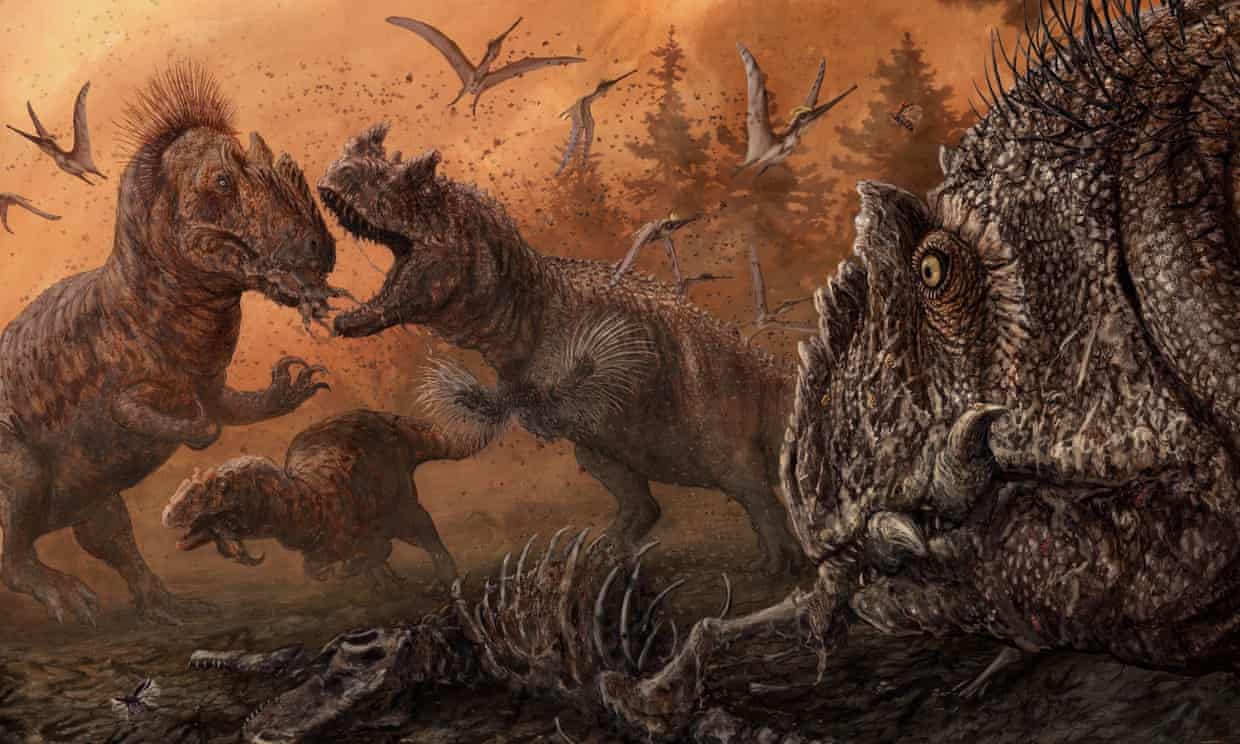
Dinosaurs
Allosaurus dinosaur suspected to be scavenging cannibal
Dinosaur-on-dinosaur dining habit revealed by scrutiny of fossil bones from Colorado site
by Nicola DavisAbout nine metres long, with grasping claws and a skull it used like a hatchet, Allosaurus was among the most fearsome dinosaurs of the Jurassic period. Now, it seems, the animal could also have been a cannibal.
Fossil researchers have revealed that bite marks found in a cache of dinosaur bones from the Mygatt-Moore quarry, western Colorado, were made by dinosaur-on-dinosaur dining. And the marks on Allosaurus bones had potentially been made by dinosaurs of their own kind.
Dr Stephanie Drumheller-Horton, first author of the research, from the University of Tennessee, said the findings shed new light on the predators.
“We’re not sure if the Mygatt-Moore preserves an unusually stressed ecosystem, where theropods like Allosaurus were eating any available food – including each other – or if this was actually normal behaviour for them, and our previous fossil collection strategies have led us astray. With either result though, we know that these animals were more willing and able to bite into bones than we previously thought.”
Writing in the journal Plos One, Drumheller-Horton and colleagues report how they examined 2,368 fossilised bones previously dug up at the quarry, which dates to about 152m years ago, encompassing the late Jurassic period.
The team found 684 of the fossils, 29% of the cache, had at least one bite mark such as a score, pit or puncture, and the marks were present on many bones, from ribs and long limbs to toes.
While some of the marks could have been due to predation, at least some were down to just scavenging, Drumheller-Horton said. “Predators usually target the meatiest bits first and work their way down through less and less nutritious parts. A big theropod trying to eat another big theropod’s toes was probably very late to the party, when the more choice sections were already eaten.”
While Drumheller-Horton said it was not clear what had made the smallest marks, the larger marks were caused by meat-eating dinosaurs, the theropods –something previously found to be rare. “There simply wasn’t anyone else in the site that could have made them,” she said, adding that some of the marks clearly had been left by serrated teeth. “That excludes other possible predators from contention, leaving only theropods to consider,” she said.
She said the most common large predator at the site, by some way, was Allosaurus, though the smaller Ceratosaurus was also present; each could have left bite marks. One bite mark, she added, was from a very large theropod, but its identity was unclear.
Crucially, while many of the bitten bones had belonged to long-necked dinosaurs called sauropods, and some had come from Mymoorapelta maysi, a type of armoured dinosaur, the team found several bite marks on Allosaurus fossils – suggesting the cannibalistic nature of Allosaurus.
Dr Stephen Brusatte, a palaeontologist at the University of Edinburgh, who was not involved in the work, said the cache was an unprecedented record of what theropod dinosaurs had been eating.
“It’s most intriguing that there are Allosaurus bones with big bite marks that are a good match for the size and shape of Allosaurus teeth,” Brusatte said. “Although it’s not completely conclusive that Allosaurus was the biter, it is one of the most reasonable conclusions – unless there was a completely unknown mega-theropod that was sharing this ecosystem with it and the others.”
Andre Rowe, a researcher at Bristol University, suggested the high prevalence of bite marks seen could be due to fossil hunters collecting particular fossils. But, he added, Allosaurus would not have been the only dinosaur eating its own. “Evidence for cannibalism is noted in a Madagascan dinosaur named Majungasaurus. It also occurs in crocodilians, some of the closest living relatives of dinosaurs.”.
Brusatte agreed. “There is evidence that the even bigger Tyrannosaurus rex was a cannibal, and many predators in today’s world are known to eat members of their own species, especially when times get tough, like during droughts or spurts of bad weather.”
But at least one dinosaur has had its reputation unfairly tarnished. “We used to think that we had evidence for cannibalism in Coelophysis too,” said Drumheller-Horton. “But that ended up being a case of mistaken identity.”